Picatinny Rail
By Norman E. Johnson
©Copyright, Precision Shooting Magazine
My association with the rifle scope and mount goes back a long way. The very first scope mount I had ever used was one I made to mount to a scope, which I also had made from an old brass telescope. This was mounted to a rifle I had brought back to life. That was back in the fading 1940s, but remains clearly etched in my memory. That first mount consisted of two bands of metal encircling the scope, with three triangularly opposing set screws in each band used to hold and adjust the scope. Overall, this scope and mount lacked a great deal of mechanical integrity, but it served a purpose. More importantly, at the age of 14, I was learning.
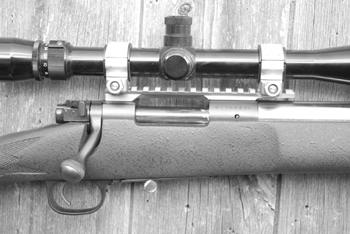
Shown here is a NEAR Picatinny rail and ring mount on a Winchester Model 70 Stealth II short-action receiver both in and out of the stock. The scope is a Redfield 8X-32X target model. The rail has a 10 MOA slope commonly used by target or varmint shooters from100-500 yards. By comparison, a 25 minute rail angle would permit elevation of 125 inches at 500 yards or 250 inches at 1000 yards. Without the sloped rail base, few scopes would permit vertical reticle setting out to 1000 yards
Since those early times I have made scope mounting a virtual work in progress. Discovering strengths and weaknesses of mounting system adaptability has always remained an important issue to me. Much of this is reflected in my writing over many years. One treatise on the subject that I authored was published in the 57th Annual Edition of GUN DIGEST (2003), entitled, "Stress Elimination in Scope Mounting."
In my work with telescopic sights, I have used a good share of the scope mounting systems ever designed. For a time, there were few scopes and mounts to choose from, and many of these failed to keep a scope in true alignment with the bore. Rifles required constant resighting to hold zero. The rifle or its load was often blamed for poor performance, when, in fact, the mounting system or scope was the culprit…sometimes both. At the same time, I have had the opportunity of observing great progress in the quality of scopes and the process used in mounting them. Scope and mount manufacturers worked diligently with firearms manufacturers to build a product that would assure a precision fit between the scope base and receiver, maintaining as close a tolerance between parts as is mechanically achievable. I would often be the first to welcome these advances in engineering, and couldn't wait to try new products. This technology evolution continues to be an interesting part of it all…and there is still progress to be made.
While striving for the final level of precision and accuracy in a rifle, my work would take me deeply into its makeup and function. There were so very many areas where problems could arise. Obviating each and every possible or likely cause of failure requires a great deal of experience and foresight.
I had not ventured far into serious shooting before losing at least some trust in the mounting system of a scope sight. Early on, there weren't many mounting methods to choose from. Many of us older shooters recall the introduction of some of the forerunners like Bill Weaver's basic quick detachable, or the Redfield Jr. system, et al. Many rifles were not even drilled and tapped for scope mounting as mounts first came on the scene.
As a mechanical minded individual, I've always suspected the overall durability of many scope-mounting systems. Poor basic design was/is the cause for some scope mount inadequacy, and once a company tools up for production, it's pretty hard to make major changes. Attaching a scope base with the relatively small 6-48 size screw was a sort of design impediment that got started within the shooting industry. Once such decisions are made, it becomes hard to change. So the 6-48 screw became and remains the norm, despite its marginal strength to withstand the required torque to keep some scope bases from moving under heavy recoil or the inevitable displacement of a scope under adverse hunting conditions.
As a long-range, winter predator shooter, keeping a rifle precisely zeroed became extremely important to me. As rifles failed to remain sighted, I put the mounting systems through some extreme tests, along with scores of scopes. Many of the findings of these tests appeared in an award-winning article in the January 1992 RIFLE Magazine, which was entered in a contest sponsored by Leica Optics.
No small number of scope mounting problems can be traced to the scope base, or bases, per se. A scope base has a very vital function. It must fit the gun receiver either as a one-piece or two-piece base. Here both the rifle manufacturers and the scope/base manufacturers must come together on specifications and maintain tolerances that are as close as possible. A few thousandths of an inch in diameter or flaw in alignment, and precision may be compromised. Some manufacturers have gone to integral scope bases like those offered by Ruger, Sako, Tikka and a few others. These built-in bases eliminate the tolerance gap of a screw-on base or bases, which is essentially stacking tolerances. However, the integral bases can still fail to give true coaxial alignment between rings, or provide the additional bridging support over the receiver provided by a good, one-piece scope base. Some conventional, one-piece scope bases are quite frail, but even these tend to add at least some rigidity as a bridging over the receiver cut out.
As a preventative measure for base-to-receiver slippage, some forms of a bonding agent can be used and is recommended by a few. Even pinning the base to the receiver with through holes in the base and into the receiver is done by a few. As I see it, these pins are "forever" measures. Regardless of the benefits of base pinning, I would not consider this method of base stabilization. I swap too many scopes and mounts on my many test rifles to consider this measure of added stabilization; and drilling extra holes in a receiver doesn't do much for a rifle's appearance or value. If I did use a bonding agent between base and receiver, it would be something like J.B. Weld or the like. This material has a bonding capacity that would secure a base in place even without screws. Application of heat would release the bond.
The modern-day scope mounting schemes must meet a lot of important criteria. For hunting rifles they need to meet the aesthetic demands of hunters and shooters. They need to be light weight enough to not add appreciable weight to the rifle, and still offer a reliably durable mounting system that allows the rifle to hold a constant zero. Many of today's scope mounting arrangements meet these needs with little compromise, both in hunting as well as target and bench rest shooting.
The Picatinny Rail Scope Mounting System
We can go a step farther to assure a more durable scope mounting system by using what is called a Rail Mount System, or sometimes called a Tactical Rail Mount System. This system essentially consists of a heavier, one-piece scope base with multiple cross slots to accept heavier-built crosspin style rings. The overall effect of the rail is to stiffen the action and provide a precision surface for these stronger rings to lock into. The remainder of this article will cover the Picatinny Rail Mounting scheme. More specifically, the rail and rings made by Near Manufacturing Ltd., Brownell's Picatinny scope base and scope rings, and Holland's Picatinny Rail Mount. There are other Picatinny or tactical arrangements by Warne, Atlas Products, Farrell Industries, Badger Ordnance, et al, all available through Brownells.
How the name Picatinny originated, I am not familiar, but I have offered my own acronym to describe PICATINNY: "Placed In Close Axial Tolerance It Never, Never Yields."
Most of the Picatinny style rails provide a graduated angle for longer range shooting. This angles the scope object lens downward toward the barrel. This normally provides 10-25 minutes of rear base elevation…a feature enabling the distance shooter to mount a scope and not run out of scope elevation adjustment. It is particularly useful for the 1,000-yard shooter or beyond. The Picatinny base also adds appreciably to the overall stiffness or rigidity of any rifle receiver. With some proprietary features offered on some units, this essentially portrays the Picatinny scope mounting system. I will provide further insight on these individual systems, including my own experience with each.
The NEAR Scope Mounting System
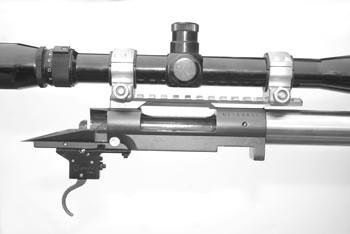
With the action removed from the stock, it clearly shows the bridging strength of the Picatinny mount system. This is apparent as it spans the receiver cutout of this rifle. Even the scope and rings add to the rigidity effect.
My first experience goes back several years with the Picatinny Rail Mount base and scope mount system manufactured by Richard Near, founder of Near Mfg. NEAR bases and rings are available in stainless or black, made of hardened stress relieved steel. Parts are CNC machined to a tolerance of 0.0003" made to Mil-Std. 1913 Picatinny specifications. Bases come with 6-48 Torx screws using all four base screws. Two additional screws are available for the strongest possible attachment that fit the two extra holes provided. Bases are available in 10 MOA taper best suited to 100-600 yard ranges, and 25 MOA for zeroes to 1200 yards. Custom bases to precisely match your optics are available by arrangement. Rings are available in 30mm, 1 inch and 34mm. Rings are attached with a very durable, fine threaded crossbolt.
Near bases are available in a good selection of gun models, including: Sako, Savage, Steyr, Std FN, Tikka, Browning A-Bolt, Parker Hale, Remington 700-40X and XP-100, Winchester M-70 and Weatherby MK-V, and perhaps other applications by now.
It was Near Manufacturing who came to my aid when I needed a Picatinny base for the Winchester Model 70 Stealth II action. My search for a one-piece base to fit the Model 70 Stealth II action from other sources netted me nothing. Four additional 8-40 screws were included with the base. Near bases have a special shoulder on the forward underside that makes precision contact with the receiver ring. I really like this feature, which would help to prevent a possibility of screw shearing or breakage on those heavy kickers.
With the Near base and rings along with a 32X Redfield scope, the Model 70 Stealth II performed extremely well with groups as small as .234" at 100-yards shooting a 25 WSSM cartridge. I have installed Near bases and rings on Remington Model 40X and Model 700 actions, and on a Model 70 Winchester action. All grouped very well…further proof of the effectiveness of the Near scope mounting system wasn't required.
Brownell's Picatinny Scope Base and Rings
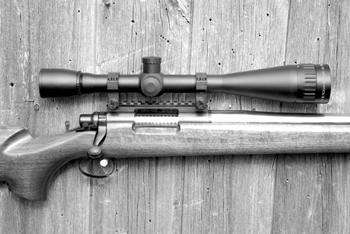
Shown here is Brownell's Picatinny rail base and rings used in mounting a 36 x 42 Sightron target scope on a Remington Model 40X rifle. Rings are mounted at extreme ends of rail, positioning this scope perfectly. Cutout in rail base coincides precisely with receiver cutout. These steel rings and base proved to be an excellent scope mounting system, delivering quarter MOA accuracy from a 6mm PPC cartridge and a Bartlein barrel.
Brownell's, in their catalog number 60, added their own Picatinny Scope Base and Picatinny Scope Rings. I have used and tested this most durable Picatinny scope mounting system and find it durable in strength and versatility. Both the cross slotted base and the rings are available in the black in either 4140 steel or 6061 T6 aluminum. They are designed for use on both tactical and sporting rifles and come equipped with 6-48 Torx head screws. These screws could, of course, be substituted with 8-40 screws offered by Brownell's in their screw conversion kit for an even stronger base mounting. The bases are available for use on Mauser 98, Rem. 700 short and long action, Savage 10 & 110 short and long action, Winchester Model 70 in short action, long action or WSM. The lighter aluminum combination would prove especially ideal for rugged use on any sporting rifle. There are more than a dozen slots cut to true Mil-Std 1913 specifications on the Picatinny rail to accept many Weaver-style rings and, of course, Brownell's own rings.
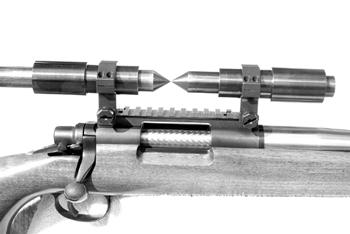
Precise coaxial alignment is of paramount importance to a totally stress-free mounted scope. Pre-determining true scope ring alignment is easily accomplished with the use of these versatile sleeved scope alignment rods offered by Brownell's. Here the alignment rods were being used to test Brownell's rail base and rings before the scope was mounted. An added advantage of the sleeved alignment rods over basic pointed rods is the means to test to see if the longer of the two rods will slide through both sleeves. This maneuver further verifies 100% perfect alignment of rings..
The Brownell Picatinny rings are 1 inch inside diameter precision machined, flat-top design available in low, medium or high heights. A sturdy hex nut tightens the ring retaining bolts, which are also coin or screwdriver slotted.
I put this base and ring combination through the necessary tests on three different rifles. After mounting, I could see they weren't going anyplace. Accuracy was superb with all three rifles. I used Brownell's Sleeved Scope Alignment Rods to verify coaxial alignment between scope rings, which proved out near perfect on all three rifles. This scope mounting system proved to be as precision and durable as it was designed to be.
Holland's Picatinny Rail Mount
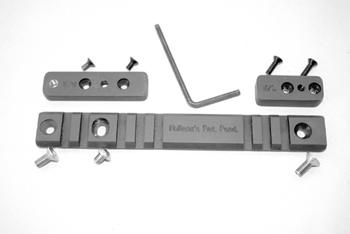
Pictured here is an unassembled view of the Holland Picatinny Rail Mount. It consists of three separate parts: a front and rear base, and the rail mount. Four 6-48 screws attach the bases to the rifle receiver and three larger 10-32 screws interface the rail to the bases. The single hole positioned at the rear of the rail allows the base to pivot on the attaching screw until fully tightened to allow for precise centering of the scope reticle for full right to left adjustment. The button screw goes into the elongated hole and the far-end screw fits the far end hole that was drilled and tapped into the base. With all screws tightened, the rail mount forms a very durable precision fit to the receiver
The third Picatinny Rail Mount that I have worked with is a quite different principle than the other two. It is manufactured by Holland's Shooters Supply.
The Holland Picatinny Rail Mount has two solid steel bases, as a second component, attached to the rifle receiver beneath the slotted rail base. The rail base has eight milled cross slots with the two widest slots spanning 7 3/4". This mounting system allows you to optically center the scope reticle for both windage and elevation, allowing maximum reticle adjustment right-and-left and up-and-down. Scopes perform best when the reticle is optically centered.
The Holland rail mounting system comes with complete and detailed instructions, which I will just briefly cover here. Some minor fitting is necessary for a perfectly centered scope…a unique feature of the Holland design.
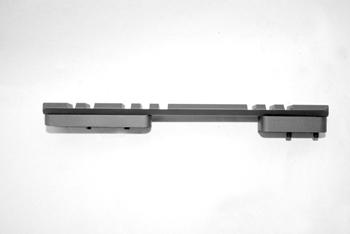
This picture shows the Holland Picatinny Rail Mount assembled as it would be attached to a rifle receiver.
First, the two bases are attached to the receiver with the four 6-48 screws. After mounting, Holland suggests checking the top surfaces of the two bases for precise alignment using a straight edge. They were in perfect alignment on the rifle I mounted them on. Where the bases are not in true alignment, they could be milled. This procedure is clearly outlined in the instructions. Such milling could also be performed to alter the angled plane of bases to change scope reticle adjustment. The bases are machined at a 20 MOA slope as received, which should be good out to 1,000 yards.
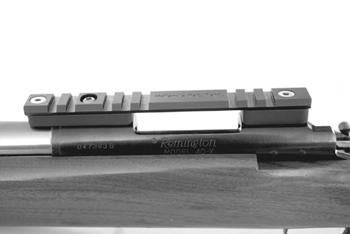
Shown here is the Holland Picatinny Rail Mount solidly attached to a Remington Model 40X rifle. Three 10-32 screws attach the rail to the bases.
The rail can now be attached to the bases with two of the three 10-32 screws provided. The rear base screw is a flat-head screw, which is not fully tightened at this time. The other front screw is a 10-32 button-head screw, which goes in the slotted front hole. This allows the base to be moved from side-to-side at the front for exact scope reticle centering with the bore.
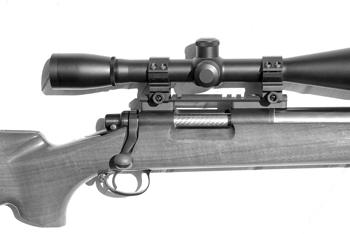
Shown here is Holland's solidly assembled Picatinny Rail Mount on a Remington Model 40X rifle with a Sightron 36X target scope and Accushot Picatinny Scope Rings. This scope/cartridge combination produced quarter minute groups with the 22 PPC cartridge and a Krieger barrel using both Sierra and Berger bullets.
Next, before mounting the scope on the rifle, center the scope reticle to center in the scope. This is accomplished by turning the reticle adjusting-knob until it reaches one end—R or L, and then count the clicks all the way to the opposite side. Divide the total clicks in half and set the reticle in this position to center it. Mount the scope on the rifle and align the reticle to the bore. This is also done for vertical reticle position at this time.
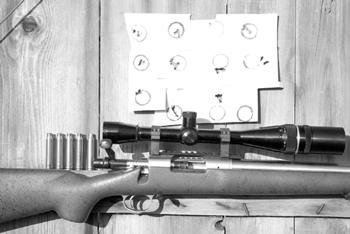
This picture is proof that the Picatinny rail mount system can withstand the heavier recoil when mounted on a standard 700 Remington action shooting a 300 Winchester Magnum cartridge. These 10 five-shot groups were shot at 100-yards using a Sierra 150 gr. HP match and Berger 155 gr. VLD Match bullets. Groups averaged under 0.60 MOA. A 36X Leupold scope was mounted on the Std. Model 700 Remington action using NEAR rail mount and NEAR rings. The action is pillarbedded into a Bell & Carlson stock. The barrel is a Douglas Premium grade. This combination is part of a two-bolt switch barrel system made up by the author converting the 700 Remington to a single-shot action.
At this point, with the scope temporarily mounted and with the reticle coinciding with the bore, remove the scope, with rings attached, from the base. This is where the final rail base attaching screw comes into use. A hole is drilled and tapped in the extreme forward end of the front base for the final 10-32 flat head attaching screw. This hole is centered, drilled and tapped through the front hole in the rail and requires attention to detail for exact centering. The screw used is a 10-32 requiring a number 22 drill size. If you lack the ability to accomplish this task, seek help. This final screw, along with the other two holding the rail base, locks things solidly in position providing an essentially custom fit Picatinny Rail Mount on your rifle. Holland's does recommend the use of a drop of Loctite to each screw after the thread surfaces are thoroughly cleaned. With this there is available a machinist's Sine-Bar to hold the action for precise milling of the bases, but this was not required as I mounted the scope on one of my Model 40X Remington rifles. The Holland Picatinny Rail Mount system provides a very solid interface between scope and receiver.
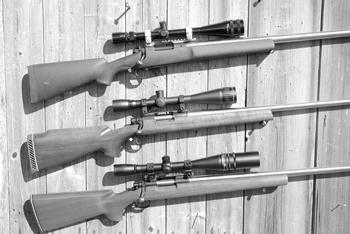
This full view shows three of the four rifles covered in the text used in mounting and testing three different Picatinny rail and scope ring mounting systems. From Top: Top: NEAR rail mount with NEAR scope rings mounted on a short action Model 70 Winchester Stealth II rifle. An 8X-32X Redfield Target scope is seen mounted here. The caliber is a 25 WSSM with a Broughton barrel. Center: Brownell's Picatinny rail mount with Brownell's Picatinny scope rings used to mount a 36x42 Sightron scope on a Remington Model 40X rifle in caliber 6mm PPC with a Bartlein barrel. Bottom: Holland's Picatinny rail mount along with Accushot Picatinny scope rings used to mount a Sightron 36x42 target scope on a Remington Model 40X rifle. The barrel is a Krieger chambered for the 22 PPC cartridge. This rail mount system allows for a perfect pre-centered scope reticle before rail was finally attached.
In conclusion, I can readily recommend any of the three Picatinny rail mounting systems that I have chosen to install and evaluate on some of the most accurate rifles available. Granted, it may not always be easy to determine—with certainty—if making a change in something like a scope base will, indeed, improve accuracy of a rifle. But sound reasoning tells us if properly placed support is added to a mechanical structure, it will yield less to outside forces, thereby improving or maintaining precision. This does not mean I'll be going out to change all my rifles to the more rigid rail system…not quite yet. Most of the properly mounted, better, conventional scope mounts perform at a near equal to, or at least perfectly satisfactory level to the rail mount systems. In both cases, mounting is critical. The choice of usage, therefore, must be well thought out and fit the intended need of each gun and its owner.
Contacts
Bell & Carlson Inc.
101 Allen Road
Dodge City, KS 67801
(620) 225-6688
bellandcarlson.com
Remington Arms Co. Inc.
870 Remington Drive
PO Box 700
Madison, NC 27025
(800) 243-9700
Sierra Bullets
PO Box 818
Sedalia, MO 65302
(800) 223-8799
sierrabullets.com
Winchester Repeating Arms
275 Winchester Avenue
Morgan, UT 84050
(801) 876-3440
winchesterguns.com
Leupold & Stevens, Inc.
14400 NW Greenbrier Pkwy.
Beaverton, OR 97006
(503) 646-9171
Holland's Shooters Supply, Inc.
PO Box 69
Powers, OR 97466
(888) 875-0950
hollandguns.com
Brownell's Inc.
200 South Front St.
Montezuma, IA 50171
(800) 741-0015
brownells.com
Sightron Inc.
100 Jeffery Way, Suite A
Youngsville, NC 27596
(919) 562-3000
sightron.com
Near Mfg. Inc.
PO Box 1677
Camrose, Alberta
T4V 1X6 Canada
(866) 608-2441
scopebases.com
Douglas Rifle Barrels, Inc.
5504 Big Tyler Road
Charleston, WV 25313
(304) 776-1341
Berger Bullets
4275 North Palm Street
Fullerton, CA 92835
(714) 447-5456
bergerbullets.com
Broughton Rifle Barrels
North Mfg. Co. Inc.
PO Box 1010
Campbellsport, WI 53010
(920) 922-4882
rifle-barrels.net
Krieger Rifle Barrels, Inc.
2024 Mayfield Road
Richfield, WI 53076
(262) 628-8558
Bartlein Barrels, Inc.
W208 N16939 N Center St.
Jackson, WI 53037
(262) 649-1574
bartleinbarrel.com
By Norman E. Johnson
©Copyright, Precision Shooting Magazine
My association with the rifle scope and mount goes back a long way. The very first scope mount I had ever used was one I made to mount to a scope, which I also had made from an old brass telescope. This was mounted to a rifle I had brought back to life. That was back in the fading 1940s, but remains clearly etched in my memory. That first mount consisted of two bands of metal encircling the scope, with three triangularly opposing set screws in each band used to hold and adjust the scope. Overall, this scope and mount lacked a great deal of mechanical integrity, but it served a purpose. More importantly, at the age of 14, I was learning.

Shown here is a NEAR Picatinny rail and ring mount on a Winchester Model 70 Stealth II short-action receiver both in and out of the stock. The scope is a Redfield 8X-32X target model. The rail has a 10 MOA slope commonly used by target or varmint shooters from100-500 yards. By comparison, a 25 minute rail angle would permit elevation of 125 inches at 500 yards or 250 inches at 1000 yards. Without the sloped rail base, few scopes would permit vertical reticle setting out to 1000 yards
Since those early times I have made scope mounting a virtual work in progress. Discovering strengths and weaknesses of mounting system adaptability has always remained an important issue to me. Much of this is reflected in my writing over many years. One treatise on the subject that I authored was published in the 57th Annual Edition of GUN DIGEST (2003), entitled, "Stress Elimination in Scope Mounting."
In my work with telescopic sights, I have used a good share of the scope mounting systems ever designed. For a time, there were few scopes and mounts to choose from, and many of these failed to keep a scope in true alignment with the bore. Rifles required constant resighting to hold zero. The rifle or its load was often blamed for poor performance, when, in fact, the mounting system or scope was the culprit…sometimes both. At the same time, I have had the opportunity of observing great progress in the quality of scopes and the process used in mounting them. Scope and mount manufacturers worked diligently with firearms manufacturers to build a product that would assure a precision fit between the scope base and receiver, maintaining as close a tolerance between parts as is mechanically achievable. I would often be the first to welcome these advances in engineering, and couldn't wait to try new products. This technology evolution continues to be an interesting part of it all…and there is still progress to be made.
While striving for the final level of precision and accuracy in a rifle, my work would take me deeply into its makeup and function. There were so very many areas where problems could arise. Obviating each and every possible or likely cause of failure requires a great deal of experience and foresight.
I had not ventured far into serious shooting before losing at least some trust in the mounting system of a scope sight. Early on, there weren't many mounting methods to choose from. Many of us older shooters recall the introduction of some of the forerunners like Bill Weaver's basic quick detachable, or the Redfield Jr. system, et al. Many rifles were not even drilled and tapped for scope mounting as mounts first came on the scene.
As a mechanical minded individual, I've always suspected the overall durability of many scope-mounting systems. Poor basic design was/is the cause for some scope mount inadequacy, and once a company tools up for production, it's pretty hard to make major changes. Attaching a scope base with the relatively small 6-48 size screw was a sort of design impediment that got started within the shooting industry. Once such decisions are made, it becomes hard to change. So the 6-48 screw became and remains the norm, despite its marginal strength to withstand the required torque to keep some scope bases from moving under heavy recoil or the inevitable displacement of a scope under adverse hunting conditions.
As a long-range, winter predator shooter, keeping a rifle precisely zeroed became extremely important to me. As rifles failed to remain sighted, I put the mounting systems through some extreme tests, along with scores of scopes. Many of the findings of these tests appeared in an award-winning article in the January 1992 RIFLE Magazine, which was entered in a contest sponsored by Leica Optics.
No small number of scope mounting problems can be traced to the scope base, or bases, per se. A scope base has a very vital function. It must fit the gun receiver either as a one-piece or two-piece base. Here both the rifle manufacturers and the scope/base manufacturers must come together on specifications and maintain tolerances that are as close as possible. A few thousandths of an inch in diameter or flaw in alignment, and precision may be compromised. Some manufacturers have gone to integral scope bases like those offered by Ruger, Sako, Tikka and a few others. These built-in bases eliminate the tolerance gap of a screw-on base or bases, which is essentially stacking tolerances. However, the integral bases can still fail to give true coaxial alignment between rings, or provide the additional bridging support over the receiver provided by a good, one-piece scope base. Some conventional, one-piece scope bases are quite frail, but even these tend to add at least some rigidity as a bridging over the receiver cut out.
As a preventative measure for base-to-receiver slippage, some forms of a bonding agent can be used and is recommended by a few. Even pinning the base to the receiver with through holes in the base and into the receiver is done by a few. As I see it, these pins are "forever" measures. Regardless of the benefits of base pinning, I would not consider this method of base stabilization. I swap too many scopes and mounts on my many test rifles to consider this measure of added stabilization; and drilling extra holes in a receiver doesn't do much for a rifle's appearance or value. If I did use a bonding agent between base and receiver, it would be something like J.B. Weld or the like. This material has a bonding capacity that would secure a base in place even without screws. Application of heat would release the bond.
The modern-day scope mounting schemes must meet a lot of important criteria. For hunting rifles they need to meet the aesthetic demands of hunters and shooters. They need to be light weight enough to not add appreciable weight to the rifle, and still offer a reliably durable mounting system that allows the rifle to hold a constant zero. Many of today's scope mounting arrangements meet these needs with little compromise, both in hunting as well as target and bench rest shooting.
The Picatinny Rail Scope Mounting System
We can go a step farther to assure a more durable scope mounting system by using what is called a Rail Mount System, or sometimes called a Tactical Rail Mount System. This system essentially consists of a heavier, one-piece scope base with multiple cross slots to accept heavier-built crosspin style rings. The overall effect of the rail is to stiffen the action and provide a precision surface for these stronger rings to lock into. The remainder of this article will cover the Picatinny Rail Mounting scheme. More specifically, the rail and rings made by Near Manufacturing Ltd., Brownell's Picatinny scope base and scope rings, and Holland's Picatinny Rail Mount. There are other Picatinny or tactical arrangements by Warne, Atlas Products, Farrell Industries, Badger Ordnance, et al, all available through Brownells.
How the name Picatinny originated, I am not familiar, but I have offered my own acronym to describe PICATINNY: "Placed In Close Axial Tolerance It Never, Never Yields."
Most of the Picatinny style rails provide a graduated angle for longer range shooting. This angles the scope object lens downward toward the barrel. This normally provides 10-25 minutes of rear base elevation…a feature enabling the distance shooter to mount a scope and not run out of scope elevation adjustment. It is particularly useful for the 1,000-yard shooter or beyond. The Picatinny base also adds appreciably to the overall stiffness or rigidity of any rifle receiver. With some proprietary features offered on some units, this essentially portrays the Picatinny scope mounting system. I will provide further insight on these individual systems, including my own experience with each.
The NEAR Scope Mounting System

With the action removed from the stock, it clearly shows the bridging strength of the Picatinny mount system. This is apparent as it spans the receiver cutout of this rifle. Even the scope and rings add to the rigidity effect.
My first experience goes back several years with the Picatinny Rail Mount base and scope mount system manufactured by Richard Near, founder of Near Mfg. NEAR bases and rings are available in stainless or black, made of hardened stress relieved steel. Parts are CNC machined to a tolerance of 0.0003" made to Mil-Std. 1913 Picatinny specifications. Bases come with 6-48 Torx screws using all four base screws. Two additional screws are available for the strongest possible attachment that fit the two extra holes provided. Bases are available in 10 MOA taper best suited to 100-600 yard ranges, and 25 MOA for zeroes to 1200 yards. Custom bases to precisely match your optics are available by arrangement. Rings are available in 30mm, 1 inch and 34mm. Rings are attached with a very durable, fine threaded crossbolt.
Near bases are available in a good selection of gun models, including: Sako, Savage, Steyr, Std FN, Tikka, Browning A-Bolt, Parker Hale, Remington 700-40X and XP-100, Winchester M-70 and Weatherby MK-V, and perhaps other applications by now.
It was Near Manufacturing who came to my aid when I needed a Picatinny base for the Winchester Model 70 Stealth II action. My search for a one-piece base to fit the Model 70 Stealth II action from other sources netted me nothing. Four additional 8-40 screws were included with the base. Near bases have a special shoulder on the forward underside that makes precision contact with the receiver ring. I really like this feature, which would help to prevent a possibility of screw shearing or breakage on those heavy kickers.
With the Near base and rings along with a 32X Redfield scope, the Model 70 Stealth II performed extremely well with groups as small as .234" at 100-yards shooting a 25 WSSM cartridge. I have installed Near bases and rings on Remington Model 40X and Model 700 actions, and on a Model 70 Winchester action. All grouped very well…further proof of the effectiveness of the Near scope mounting system wasn't required.
Brownell's Picatinny Scope Base and Rings

Shown here is Brownell's Picatinny rail base and rings used in mounting a 36 x 42 Sightron target scope on a Remington Model 40X rifle. Rings are mounted at extreme ends of rail, positioning this scope perfectly. Cutout in rail base coincides precisely with receiver cutout. These steel rings and base proved to be an excellent scope mounting system, delivering quarter MOA accuracy from a 6mm PPC cartridge and a Bartlein barrel.
Brownell's, in their catalog number 60, added their own Picatinny Scope Base and Picatinny Scope Rings. I have used and tested this most durable Picatinny scope mounting system and find it durable in strength and versatility. Both the cross slotted base and the rings are available in the black in either 4140 steel or 6061 T6 aluminum. They are designed for use on both tactical and sporting rifles and come equipped with 6-48 Torx head screws. These screws could, of course, be substituted with 8-40 screws offered by Brownell's in their screw conversion kit for an even stronger base mounting. The bases are available for use on Mauser 98, Rem. 700 short and long action, Savage 10 & 110 short and long action, Winchester Model 70 in short action, long action or WSM. The lighter aluminum combination would prove especially ideal for rugged use on any sporting rifle. There are more than a dozen slots cut to true Mil-Std 1913 specifications on the Picatinny rail to accept many Weaver-style rings and, of course, Brownell's own rings.

Precise coaxial alignment is of paramount importance to a totally stress-free mounted scope. Pre-determining true scope ring alignment is easily accomplished with the use of these versatile sleeved scope alignment rods offered by Brownell's. Here the alignment rods were being used to test Brownell's rail base and rings before the scope was mounted. An added advantage of the sleeved alignment rods over basic pointed rods is the means to test to see if the longer of the two rods will slide through both sleeves. This maneuver further verifies 100% perfect alignment of rings..
The Brownell Picatinny rings are 1 inch inside diameter precision machined, flat-top design available in low, medium or high heights. A sturdy hex nut tightens the ring retaining bolts, which are also coin or screwdriver slotted.
I put this base and ring combination through the necessary tests on three different rifles. After mounting, I could see they weren't going anyplace. Accuracy was superb with all three rifles. I used Brownell's Sleeved Scope Alignment Rods to verify coaxial alignment between scope rings, which proved out near perfect on all three rifles. This scope mounting system proved to be as precision and durable as it was designed to be.
Holland's Picatinny Rail Mount

Pictured here is an unassembled view of the Holland Picatinny Rail Mount. It consists of three separate parts: a front and rear base, and the rail mount. Four 6-48 screws attach the bases to the rifle receiver and three larger 10-32 screws interface the rail to the bases. The single hole positioned at the rear of the rail allows the base to pivot on the attaching screw until fully tightened to allow for precise centering of the scope reticle for full right to left adjustment. The button screw goes into the elongated hole and the far-end screw fits the far end hole that was drilled and tapped into the base. With all screws tightened, the rail mount forms a very durable precision fit to the receiver
The third Picatinny Rail Mount that I have worked with is a quite different principle than the other two. It is manufactured by Holland's Shooters Supply.
The Holland Picatinny Rail Mount has two solid steel bases, as a second component, attached to the rifle receiver beneath the slotted rail base. The rail base has eight milled cross slots with the two widest slots spanning 7 3/4". This mounting system allows you to optically center the scope reticle for both windage and elevation, allowing maximum reticle adjustment right-and-left and up-and-down. Scopes perform best when the reticle is optically centered.
The Holland rail mounting system comes with complete and detailed instructions, which I will just briefly cover here. Some minor fitting is necessary for a perfectly centered scope…a unique feature of the Holland design.

This picture shows the Holland Picatinny Rail Mount assembled as it would be attached to a rifle receiver.
First, the two bases are attached to the receiver with the four 6-48 screws. After mounting, Holland suggests checking the top surfaces of the two bases for precise alignment using a straight edge. They were in perfect alignment on the rifle I mounted them on. Where the bases are not in true alignment, they could be milled. This procedure is clearly outlined in the instructions. Such milling could also be performed to alter the angled plane of bases to change scope reticle adjustment. The bases are machined at a 20 MOA slope as received, which should be good out to 1,000 yards.

Shown here is the Holland Picatinny Rail Mount solidly attached to a Remington Model 40X rifle. Three 10-32 screws attach the rail to the bases.
The rail can now be attached to the bases with two of the three 10-32 screws provided. The rear base screw is a flat-head screw, which is not fully tightened at this time. The other front screw is a 10-32 button-head screw, which goes in the slotted front hole. This allows the base to be moved from side-to-side at the front for exact scope reticle centering with the bore.

Shown here is Holland's solidly assembled Picatinny Rail Mount on a Remington Model 40X rifle with a Sightron 36X target scope and Accushot Picatinny Scope Rings. This scope/cartridge combination produced quarter minute groups with the 22 PPC cartridge and a Krieger barrel using both Sierra and Berger bullets.
Next, before mounting the scope on the rifle, center the scope reticle to center in the scope. This is accomplished by turning the reticle adjusting-knob until it reaches one end—R or L, and then count the clicks all the way to the opposite side. Divide the total clicks in half and set the reticle in this position to center it. Mount the scope on the rifle and align the reticle to the bore. This is also done for vertical reticle position at this time.

This picture is proof that the Picatinny rail mount system can withstand the heavier recoil when mounted on a standard 700 Remington action shooting a 300 Winchester Magnum cartridge. These 10 five-shot groups were shot at 100-yards using a Sierra 150 gr. HP match and Berger 155 gr. VLD Match bullets. Groups averaged under 0.60 MOA. A 36X Leupold scope was mounted on the Std. Model 700 Remington action using NEAR rail mount and NEAR rings. The action is pillarbedded into a Bell & Carlson stock. The barrel is a Douglas Premium grade. This combination is part of a two-bolt switch barrel system made up by the author converting the 700 Remington to a single-shot action.
At this point, with the scope temporarily mounted and with the reticle coinciding with the bore, remove the scope, with rings attached, from the base. This is where the final rail base attaching screw comes into use. A hole is drilled and tapped in the extreme forward end of the front base for the final 10-32 flat head attaching screw. This hole is centered, drilled and tapped through the front hole in the rail and requires attention to detail for exact centering. The screw used is a 10-32 requiring a number 22 drill size. If you lack the ability to accomplish this task, seek help. This final screw, along with the other two holding the rail base, locks things solidly in position providing an essentially custom fit Picatinny Rail Mount on your rifle. Holland's does recommend the use of a drop of Loctite to each screw after the thread surfaces are thoroughly cleaned. With this there is available a machinist's Sine-Bar to hold the action for precise milling of the bases, but this was not required as I mounted the scope on one of my Model 40X Remington rifles. The Holland Picatinny Rail Mount system provides a very solid interface between scope and receiver.

This full view shows three of the four rifles covered in the text used in mounting and testing three different Picatinny rail and scope ring mounting systems. From Top: Top: NEAR rail mount with NEAR scope rings mounted on a short action Model 70 Winchester Stealth II rifle. An 8X-32X Redfield Target scope is seen mounted here. The caliber is a 25 WSSM with a Broughton barrel. Center: Brownell's Picatinny rail mount with Brownell's Picatinny scope rings used to mount a 36x42 Sightron scope on a Remington Model 40X rifle in caliber 6mm PPC with a Bartlein barrel. Bottom: Holland's Picatinny rail mount along with Accushot Picatinny scope rings used to mount a Sightron 36x42 target scope on a Remington Model 40X rifle. The barrel is a Krieger chambered for the 22 PPC cartridge. This rail mount system allows for a perfect pre-centered scope reticle before rail was finally attached.
In conclusion, I can readily recommend any of the three Picatinny rail mounting systems that I have chosen to install and evaluate on some of the most accurate rifles available. Granted, it may not always be easy to determine—with certainty—if making a change in something like a scope base will, indeed, improve accuracy of a rifle. But sound reasoning tells us if properly placed support is added to a mechanical structure, it will yield less to outside forces, thereby improving or maintaining precision. This does not mean I'll be going out to change all my rifles to the more rigid rail system…not quite yet. Most of the properly mounted, better, conventional scope mounts perform at a near equal to, or at least perfectly satisfactory level to the rail mount systems. In both cases, mounting is critical. The choice of usage, therefore, must be well thought out and fit the intended need of each gun and its owner.
Contacts
Bell & Carlson Inc.
101 Allen Road
Dodge City, KS 67801
(620) 225-6688
bellandcarlson.com
Remington Arms Co. Inc.
870 Remington Drive
PO Box 700
Madison, NC 27025
(800) 243-9700
Sierra Bullets
PO Box 818
Sedalia, MO 65302
(800) 223-8799
sierrabullets.com
Winchester Repeating Arms
275 Winchester Avenue
Morgan, UT 84050
(801) 876-3440
winchesterguns.com
Leupold & Stevens, Inc.
14400 NW Greenbrier Pkwy.
Beaverton, OR 97006
(503) 646-9171
Holland's Shooters Supply, Inc.
PO Box 69
Powers, OR 97466
(888) 875-0950
hollandguns.com
Brownell's Inc.
200 South Front St.
Montezuma, IA 50171
(800) 741-0015
brownells.com
Sightron Inc.
100 Jeffery Way, Suite A
Youngsville, NC 27596
(919) 562-3000
sightron.com
Near Mfg. Inc.
PO Box 1677
Camrose, Alberta
T4V 1X6 Canada
(866) 608-2441
scopebases.com
Douglas Rifle Barrels, Inc.
5504 Big Tyler Road
Charleston, WV 25313
(304) 776-1341
Berger Bullets
4275 North Palm Street
Fullerton, CA 92835
(714) 447-5456
bergerbullets.com
Broughton Rifle Barrels
North Mfg. Co. Inc.
PO Box 1010
Campbellsport, WI 53010
(920) 922-4882
rifle-barrels.net
Krieger Rifle Barrels, Inc.
2024 Mayfield Road
Richfield, WI 53076
(262) 628-8558
Bartlein Barrels, Inc.
W208 N16939 N Center St.
Jackson, WI 53037
(262) 649-1574
bartleinbarrel.com

